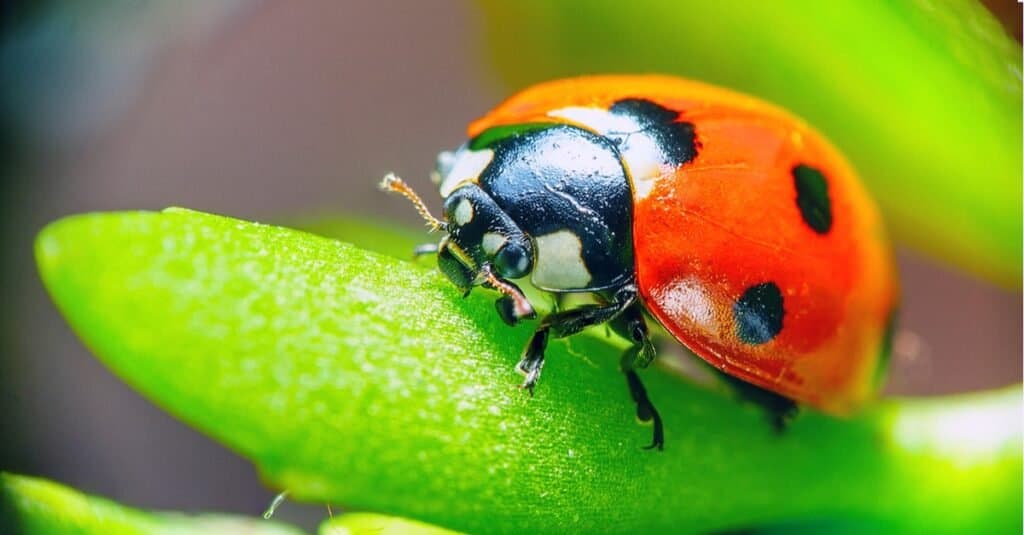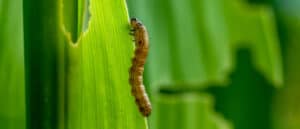- The damage they cause is estimated to cost millions of dollars a year.
- Mature pests can be identified by stripes running down the lengths of their bodies.
Armyworms, also referred to as caterpillars and moths, are threats to ecosystems wherever you find them. And what makes armyworms so bad? The insects travel in massive groups, apparently even across countries, and destroy crops, lawns, trees, and near any organic matter in their path in fast, scarily efficient manners. The creatures are the causes of millions of dollars in property damage a year.
Armyworms: How to Identify the Insects
It can be difficult to find identifying marks on newly hatched caterpillars. The older larvae have unique strips running along the length of the body. Fall armyworms have yellow stripes over brown bodies. Beet armyworms have green bodies with light stripes. The adult is a gray, mottled month with a wingspan of 1½ inch and a small white dot at the center of their forewing. There’s also a dark marking on the hind wings.
Armyworms: What Does the Armyworm Do?

©iStock.com/ossyugioh
The armyworm is a destructive pest in several parts of the world. Here in the States, you find it mostly in the Southwest. It hosts and feeds on over 60 plants, including corn, forage grasses, cotton, alfalfa, soybeans, and nearly all vegetable crops.
The species has two strains: the rice and corn strains. The rice strain caterpillars feed on crops too but seem to lean toward green, lush, well-fertilized bermudagrass. Curiously, the armyworm doesn’t necessarily kill healthy bermudagrass. The defoliation by the swarm causes plants to weaken. The final result is livestock loses pasture and the hay producer has nothing to cut.
Other armyworms look for pearl millet, bahiagrass, tall fescue, and sorghum-sudan hybrids. They also seek wheat, ryegrass, rye, and oats. Whatever their preferences, it’s not unusual that in the midst of their infestations these animals chow on almost anything they come across that results in excessive crop and grass damage.
There are typically three generations of life cycles for armyworms every year. These infestations are numerous in the late summer and early fall. Reports of the damage start in late July or early August, usually coming out of southern Alabama. It’s also not unusual for severe outbreaks to start in mid-April.
The generations tend to die off after about a month due to severe summer heat. But, typically, the next generation can produce just as you’re getting rid of the current generation. There are rare regions with mild winters (mostly in the deep south) where armyworms overwinter, keeping pupae and eggs beneath the soil. Where climates are warm pretty much year-round, armyworms can be active the entire year.
The creatures cannot adapt to the cold. Alabama commonly has mild winters and armyworms don’t generally make it through them. Yet, it’s not unusual to find the creatures during a killing frost. The animals are capable of thriving in risky drought environments. But, under harsh circumstances, the level of grass damage gets reduced as the armyworm development slows in cooler temperatures.
Reports show the insects use air currents to travel to southern Texas, southern Florida, and as far as South and Central America. The timing and size of these flights influence the pest’s threat potential.
Armyworms: Impact of Their Destructive Behavior
In the larval stage, armyworms are a threat to a range of crops and grasses. They move in a regimental pattern that’s reminiscent of a military march, hence their name. The attack is largely aerial with moths arriving in the dark to lay eggs.
Armyworms chew at plant tissue. They tend to be active early morning and late afternoon into the early evening. But on fertile ground, such as unmowed, tall grass, you’ll observe them feeding all day. If they find well-kept hayfields, the armyworm larvae settle into the deep sod to escape warmer hours of the day.
As they don’t eat much, young armyworms don’t cause the bulk of destruction. Causes of the vast majority of damage you can attribute to the older members of the communities. Studies show that in four days of feed, the oldest caterpillars are capable of eating more than all other ages combined!
Outbreaks often appear to happen overnight. Armyworms work fast and the creatures’ size makes detection difficult. The larger armyworm can be gone before you find grass damage. The insects burrow below surfaces to pupate or immediately go searching for fresh food. The larger armyworms often invade adjacent uninfested areas immediately after a feed.
The damage varies in severity and appearance based on grass type and management procedures. In fields that are closely grazed, the foliage looks as if it’s thinning and getting brown spots. The surface looks browned or burned out. That’s the result of dehydration from armyworm larvae eating and destroying tender plants. The appearance gives off the impression you’re looking at grass damage due to drought as opposed to an infestation.
In pastures and hayfields, the armyworm attack can leave the region absent of green material. There may only be stems protruding from beneath the soil. The grass damage is common for tall fescue, winter annuals, and orchardgrass. Seedlings of plants are minimal when populations of armyworms are in effect. Seasonal crops get killed and severely stunted as armyworms take their feed far down on foliage.
Armyworms: Controlling Infestation

©Mironmax Studio/Shutterstock.com
Unfortunately, the best way to control armyworm outbreaks is to keep their natural enemies around. They include beneficial insects, birds, and larvae predators. If your grounds are being swarmed, it’s most likely your area lack these creatures.
The absence of armyworm predators gives the fast and constantly re-generating armies of caterpillars ample opportunity to keep the life cycle going. Ironically, in many cases, the armyworm predator populace is scarce because of the very measures, such as insecticides and sprays, used to kill off the armyworms.
Here are some of the safer, organic methods for managing infestations and grass damage to your property.
- Your first line of organic defense is the insects who feed on army worms. Try to avoid harmful insecticides and practices that might inadvertently destroy the predators. The list includes ground and rove beetles. There are flies and species of parasitic wasps that commonly seek and kill army worm larvae.
- One can minimize possible infestation by controlling or eliminating grassy weeds in your field and borders. Egg-laying will be significantly reduced and so will termigration.
- Install pheromone traps. These devices track the arrival of the moths. Upon first notice of army worms — keep an eye out for the white dot on the forewings — you want to manage closer inspections of plants and watch for signs of disruption in the growth of lawns and other greenery.
- If your region’s prone to attacks, search for signs of field, garden and grass damage starting in the early spring. A good place to search is new growth and the undersides of leaves. Upon discovery, handpick the insects and drop them in soapy water.
- Trichogramma wasps, tiny insects at one millimeter or less, will parasitize newly laid eggs left by army worms. The wasps will kill the insects before army worms get to the plant-eating larval stage in the life cycle.
- There are other insects that can help curb the infestation. Ladybugs, the lacewing and minute pirate bugs eat both army worm eggs and young larvae. These are what we call beneficial insects, creatures that aid in the control of harmful pests like armyworms, earworms, aphids, cutworms, cabbage loopers, and mites and insect eggs.
- Carefully plant to attract beneficial insects and birds. Birds love the moths and happily snatch larvae from plants and lawns. Come the fall, uncover and flip soil before putting it to bed. You then give birds a good chance at getting to exposed pupae.
- Whether you’ve had an actual infestation, simply want to manage the condition or you’re looking at a wet, cool spring that encourages armyworms, consider turning to beneficial nematodes. Placed in soil, the microscopic animals eat the pupae, eggs and larvae of close to 200 invaders. They don’t damage vertebrates (human or amphibians), won’t hurt plants, earthworms or honey bees and, lastly, are not threats to beneficial insects like the Trichogramma wasp. But the beneficial nematodes take out any army worm pupae and eggs in the soil.
- You can kill these caterpillars with applications of a solid garden insect spray.
- Once in the season, use a natural horticultural oil spray. Apply them to plants where you’re seeing indications of larvae and mites. The solution also minimizes the growth of fungus. Use it for complete coverage, especially on the undersides of leaves and on junctions with stems.
- There are fast-acting organic insecticides for when the infestation becomes intolerable.
- Some situations are going to require the use of a professional army worm exterminator experienced in dealing with an infestation. To manage army worms while maintaining your ecosystem, we suggest you find and work only with contractors using organic methods that don’t damage other elements of your environment.
Up Next…
Keep reading these posts for more incredible information about key animal facts.
- How to Get Rid of Army Worms: They’re exceptionally voracious and will take on trees, shrubs, and grasses in a quest to quell their hunger. Find out how to get rid of these pests so they never bother you again.
- What Do Mealworms Eat? They’re a favorite food of pets including reptiles, avians, and insects. But what do they eat themselves? We reveal all here and even show you how to raise your own.
- What Do Earthworms Eat?: A permanent fixture in gardens everywhere, they aerate the soil and enrich it too. We reveal how they get the energy they need to play this essential role.
The photo featured at the top of this post is © kale kkm/Shutterstock.com
Thank you for reading! Have some feedback for us? Contact the AZ Animals editorial team.






